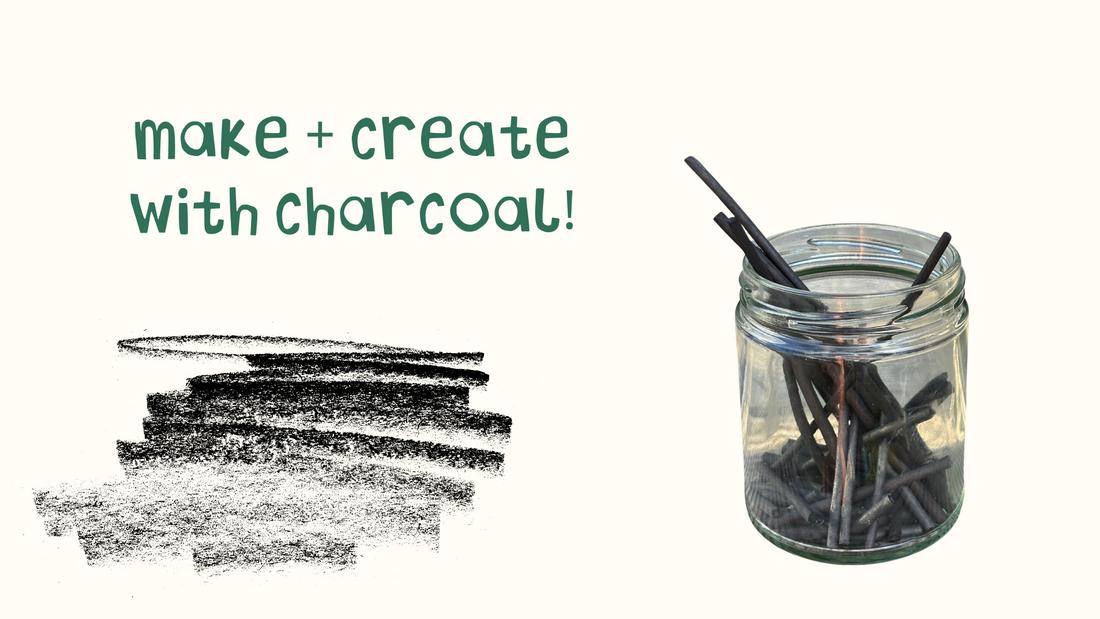
Charcoal: How to make + create with it!
Share
Our February Nature Club box used charcoal for making treasure maps! You might have some leftover from your box—so here are a few more fun ways to use it for nature play.

Did you know you can make your own charcoal?
Making your own charcoal is a great way to show children how this natural art tool is created, and it’s surprisingly simple to do.
What you'll need:
- A small metal tin with a lid (an old mint or coffee tin works well) or aluminium foil
- Small sticks or twigs (we used dried grapevine twigs, but willow, oak, or grapevine all work well)
- A vegetable peeler (subscribers—you have one in your box!)
- A campfire, fire-pit, or indoor enclosed fire.
How to do it:
- Prepare your twigs by using a vegetable peeler to remove the bark if necessary - bark doesn’t make great charcoal. If you're using grapevine, you can skip this step.
- Make sure all the twigs you put in the fire are either dried or fresh green wood. Mixing the two won’t burn evenly.
- If using a tin, fill it with your sticks and twigs, then poke a small hole in the lid to allow gases to escape. If you don’t have a tin, you can wrap the sticks tightly in aluminium foil instead.
- Place the tin or wrapped sticks in the embers of a fire and let them sit for a couple of hours.
- You’ll see smoke coming out of the holes—this is moisture and gases burning off. Once the smoke slows down, remove them carefully (use tongs or fire gloves).
- Let them cool completely before opening. Inside, you’ll find homemade charcoal sticks, ready for drawing!
Why charcoal?
Charcoal offers a completely different experience from working with paint, crayons, or pencils. It’s a great way to explore light and dark, shading and smudging, and free-flowing creative expression.
Charcoal is also perfect for process art—where the focus is on the experience rather than the final product. Unlike some outcome-based activities, process art gives you the freedom to experiment and create without worrying about making something that looks a certain way.
Now that you’ve got some charcoal, here are a few fun ways to use it.

1. Charcoal leaf and bark rubbings
This is a fun way to explore textures in nature while creating unique patterns on paper.
What you'll need:
- A piece of charcoal (homemade, from your Nature Club box, or purchased from an art shop)
- Paper
- Leaves or bark with interesting textures (could try shells, seed pods, feathers?)
How to do it:
Find leaves or tree bark with detailed textures—veins, ridges, or grooves work best. Place your paper over the top and gently rub the charcoal across it. You can layer different leaves or mix in coloured pencils to add extra detail.
2. Charcoal and water painting
Mixing charcoal with water creates an inky, smudgy paint that can be used to make bold strokes and soft washes of colour.
What you'll need:
- Charcoal sticks (homemade, from your Nature Club box, or purchased from an art shop)
- A small bowl of water
- A paintbrush or cotton bud
- Paper or wood
How to do it:
Dip the charcoal into water and see how it changes. It becomes smoother and darker, almost like an ink stick. Try drawing with wet and dry charcoal to see the difference, or crush a little piece into water to make a natural charcoal paint. You can also dip a brush into the charcoal wash and use it like watercolour paint for dreamy, soft designs. What would happen if you added watercolour paints to this process?
3. Charcoal “cave art” wall
Children will love creating symbols, simple shapes and maybe even animal prints!
What you’ll need:
- Brown paper, kraft paper, or a cardboard box flattened out
- Charcoal
- Optional: chalk or ochre-coloured crayons for contrast
What to do:
Tape paper to a wall or tree outside to act like a “cave wall.” Invite children to draw animals, hands, symbols, or their own versions of ancient markings.
You can even use hands to make charcoal handprints by tracing around them and shading in the background. Maybe you can try writing a story using symbols?
Let them take the lead
One of the best ways to use charcoal is to let little ones explore. Give them a large sheet of paper and encourage them to make big, bold marks, smudge with their fingers, press hard to make dark lines, or experiment with different strokes.
Set up some flowers, branches or other shapes as a drawing prompt. Look closely at the petals, leaves, stem, shapes - then try creating them with charcoal. This is a great way to slow down and observe what's around us in a different way!
Play with charcoal!
Charcoal is such a simple material, but it opens up endless opportunities for creativity. It’s easy for little hands to use, works beautifully with natural elements, and encourages children to express themselves with a new medium. And it's even cooler when you make something like this yourself and add it to your art supplies at home!
